New study says left-over planetesimals, not asteroids, created the moon's largest craters
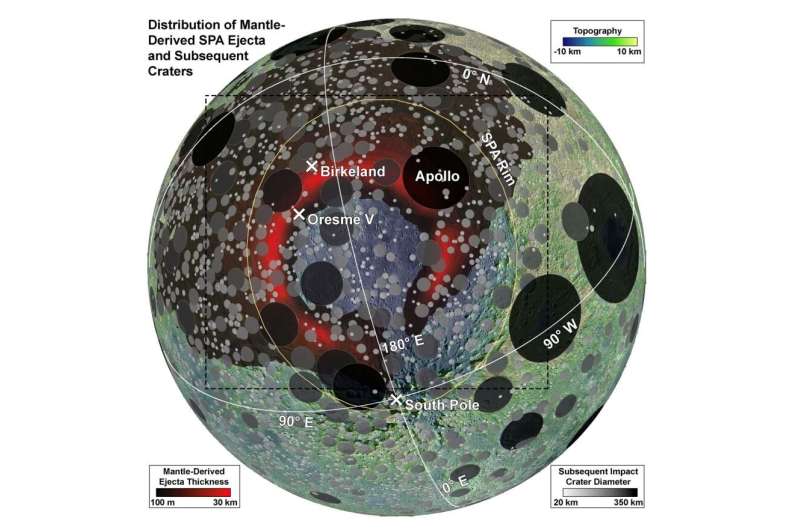
The moon's pock-marked surface tells the story of its history. It's marked by over 9,000 impact craters, according to the International Astronomical Union (IAU.) The largest ones are called impact basins, not craters. Now, a new study published in The Astrophysical Journal Letters claims that asteroids didn't create the basins; leftover planetesimals did.
The giant impact hypothesis espouses the idea that the moon was created when a Mars-sized protoplanet slammed into Earth about 4.5 billion years ago. The collision sent molten material into orbit around Earth. Some of that material fell to Earth, and some coalesced to become the moon.
As the molten rock coalesced, the moon experienced a phase called the lunar magma ocean (LMO). The moon's entire surface was molten during the LMO, and while astronomers do not doubt that massive objects collided with the moon during that episode, there's no record of them. Only once the moon solidified could impacts leave a lasting mark.
Researchers try to understand the moon by piecing together the history of lunar impacts, and the solidification of the LMO marks hour zero for the moon's impact record. Since the moon is geologically inactive, every impactor that struck the moon since hour zero left a mark that's still there to this day.
Some of the moon's craters are so vast that they're called impact basins, not craters. Basins are not only larger than craters, but they're also more complex and tend to have a central peak ring rather than a single central peak. Features larger than 300 km are called lunar impact basins, and there are about 50 of them. The moon's largest impact basin is the South-Pole Aitken (SPA) basin, and it's 2,494.5 kilometers (1,550 miles) in diameter. Texas could fit inside it.
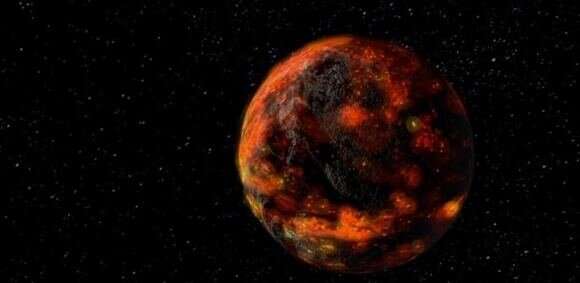
A new study says the leftover terrestrial planetesimals formed these basins when they slammed into the moon. The study, titled "Formation of Lunar Basins from Impacts of Leftover Planetesimals," is published in The Astrophysical Journal Letters. The lead author is David Nesvorný from the Southwest Research Institute (SwRI.)
The impactors that created the basins played a huge role in the moon's history and controlled much of its geology. When they struck, they removed existing crust material from the innermost peak ring and thickened the crust between the inner peak ring and the outer rim crest. The moon's mare basalts, which the Apollo missions sampled, are mostly confined to the topographic depressions in the middle of the basins.
The impacts also created faulting and other deformations over large regions of the lunar surface and excavated mantle material. This exposed mantle material holds clues to fundamental planetary formation and evolution processes.
Some impact basins are still referred to as lunar mares because of their appearance. Ancient humans thought the dark regions inside the basins were oceans. The basins became filled with basaltic lava not when they were initially formed but when other impactors struck the opposite side of the moon from the basins and triggered volcanic activity. Mares cover about 16% of the lunar surface.
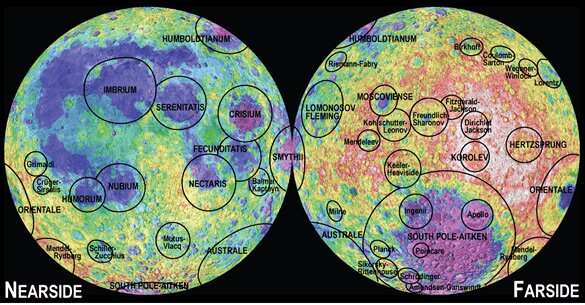
When these basins form, the impact spreads ejecta far and wide, which helps researchers piece together the moon's history. A crater on top of the ejecta must be younger than the impact basin, and if a basin partially buries a crater, then the crater is older.
Previous research showed that asteroids from the main belt are responsible for these impact basins. "The basin-forming impactors were suspected to be asteroids released from an inner extension of the main belt (1.8–2.0 au)," the authors write. But in their paper, the authors say that most impactors were planetesimals. "Here, we show that most impactors were instead rocky planetesimals left behind at ~0.5–1.5 au after the terrestrial planet accretion."
More planetesimals collided with the moon than show up in the record because planetesimals were more plentiful earlier in the solar system's history, and some would have struck during the moon's LMO phase. "… the first ~200 Myr of impacts are not recorded on the lunar surface," the researchers explain.
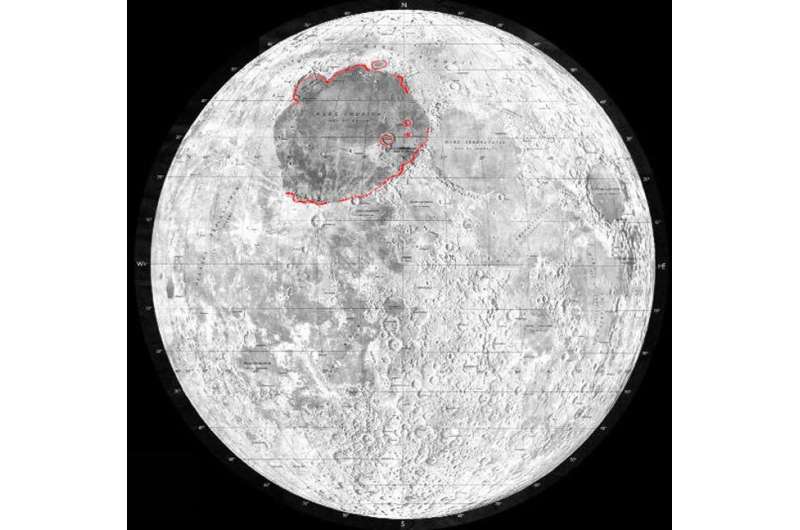
The researchers created models to determine planetesimals' role in forming the lunar basins. They based their models on previous research into terrestrial planet accretion that shows how planetesimals changed over time due to collisions with other objects. This is called collisional grinding, which eventually results in a uniform size distribution of planetesimals. They also relied on the dynamical modeling of asteroids and comets to see what role they played in lunar impacts.
The authors' work shows that asteroid impacts created the most impacts in the last 3.5 billion years. But before that, planetesimals did most of the damage. "The integrated history of lunar impacts shows that leftover planetesimals dominated the early impact flux (t < 1.1 Gyr or T > 3.5 Ga; T is measured looking backward from today)," the researchers said. Comets created some impact craters in the solar system, but not many, compared to asteroids and planetesimals.
Their results also show that about 500 20km diameter planetesimals struck the moon during its LMO phase. But those impacts left no lasting mark.
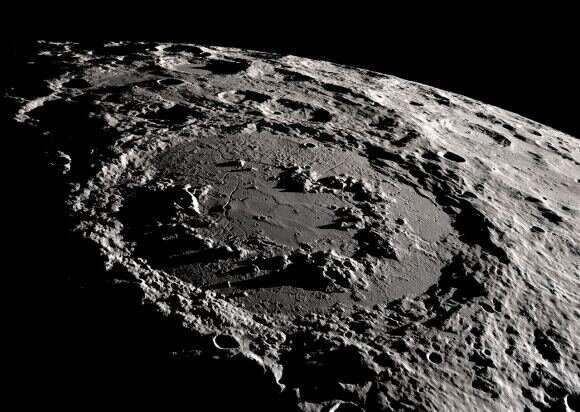
The prominent Imbrium basin is a bit of an outlier, according to this work. In their model, the planetesimal that created the Imbrium basin "occurs with a 15%–35% probability," was greater than or equal to about 100 km in diameter, and struck about 3.92 billion years ago. The authors say it must have formed late because it only has two smaller basins overlying it.
The results are supported by impacts on Earth, too. But without impact craters to study, researchers rely on spherule beds. When impactors strike Earth, they create a plume of vaporized rock. The rock condenses into tiny sphere-shaped rocks called spherules that shower back onto the Earth. They form spherule beds embedded in rock. "Our model predicts ~20 d > 10 km impacts on the Earth for T = 2.5–3.5 Ga.," the study says. "This is similar to the number of known spherule beds in the late Archean."
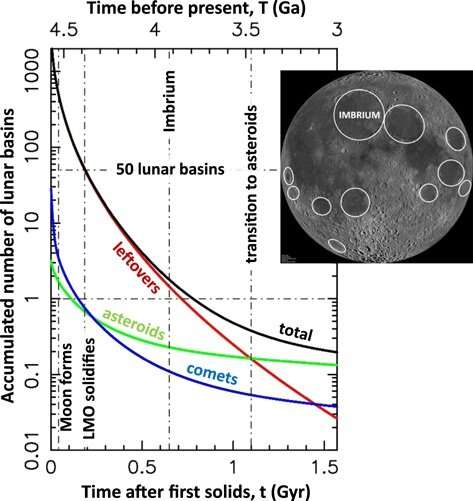
In this time interval, both main-belt asteroids and leftover planetesimals struck Earth. But, they write, "Whereas the asteroid impacts were more uniformly spread over the late Archean, nearly all planetesimal impacts should have happened before 3 Ga."
Researchers are still studying the moon's craters and piecing together the solar system's history. While the IAU officially recognizes 9,137 craters, of which 1,675 have been dated, these numbers are likely to change. New research based on data from China's Chang'e lunar orbiter puts the number of craters closer to 130,000. Other research puts the number even higher: two million craters larger than 1–2 km.
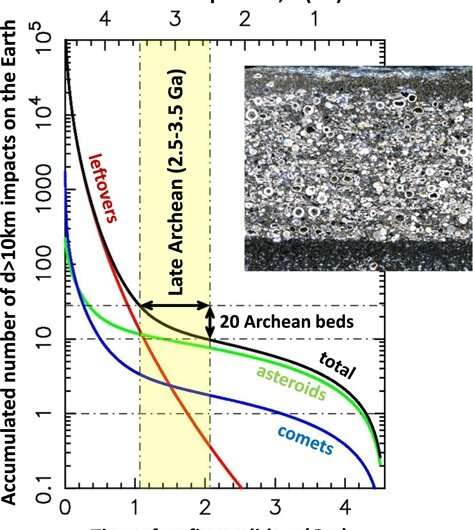
Whatever the eventual number, each crater is like a fossil. Earth lacks this fossil record, and piecing together the impact fossil record on the moon not only reveals the moon's history but Earth's as well.
More information: David Nesvorný et al, Formation of Lunar Basins from Impacts of Leftover Planetesimals, The Astrophysical Journal Letters (2022). DOI: 10.3847/2041-8213/aca40e
Journal information: Astrophysical Journal Letters
Provided by Universe Today





















